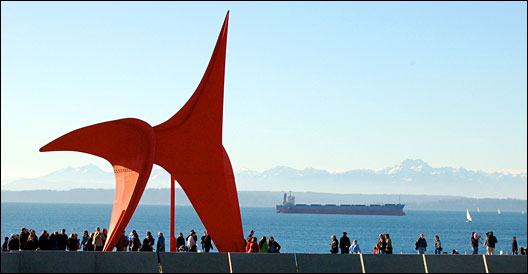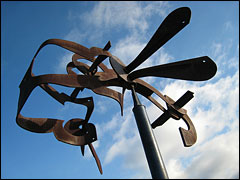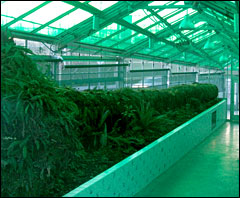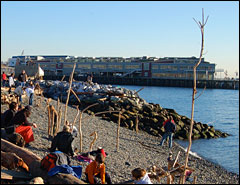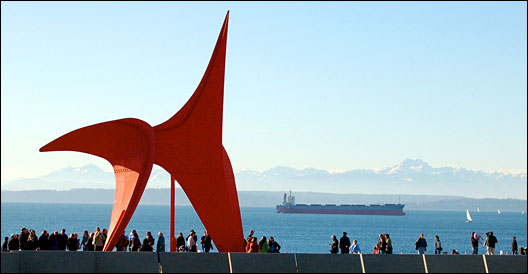
I’ve never seen the Pacific Northwest. I mean, I live in Seattle, and I look around, but I’ve never really seen it.
I came to this realization while walking the zig-zagged trail at Seattle’s new Olympic Sculpture Park with Grist mascot Chip Giller and two OSP guides. It took nearly the entire tour for this sad realization to fully evolve.
I had walked through the events facility and café, I had oohed and ahed at a 150-year-old decaying nurse log set up in a state-of-the-art greenhouse, I had marched up the crushed gravel path through the aspen grove, down near the salmon-friendly sloping seawall to the driftwood-covered waterfront beach, past sculptures leagues taller than me.
But it wasn’t until Martha Wyckoff, an environmental consultant for the park project, pointed out the tiny snowberries at our feet that it became clear. She mentioned that she had recently seen a girl crouching to photograph the pea-sized berries and realized that this girl must not have ever seen them before. How could this be, she asked. You’d find them on any Pacific Northwest hiking trail.
I admitted that I too had marveled at the delicate white orbs, hundreds of them in the patch before us. I hadn’t seen anything like it growing up on the East Coast.
As I spoke, I realized it was all new to me — the snowberries, the driftwood, the aspens, the ancient tree. And then I realized exactly what — and who — this park was for.
City Slick
From the windows in my downtown apartment, I can see a handful of trees, but they’re all the wimpy displaced sort, strung up by wire and trapped in metal grating. On my walk to work each morning and to the grocery store every Sunday, a similar landscape. Skinny little sticks of trees in a sea of pavement and skyline-worthy signs of progress.
I’d never tell you there’s not beauty in my life as a city girl. The vibrant colors polka-dotting the fruit and vegetable stands at the Pike Place Farmers Market, the neon lights of the Paramount Theater glittering in the night sky, hell, even the fact that I can walk just about anywhere — it’s a beautiful thing.
But living deep in the city’s core, I sometimes forget the lush, green world out there. Though the Pacific Northwest scenery drew me here, my outdoors reality isn’t a hiking trail on Mount Rainier or the vista at Snoqualmie Falls — it’s Westlake Center park, with its checkered pavement and Christmas carousel.
And I am not alone. Though Seattle is home to more granola types than a Quaker Oats factory, it, like any city, is also home to a great number of citizens who will never get the chance to travel outside the city limits to climb a rugged trail or hug any kind of respectable tree.
Therein lies the beauty of the Olympic Sculpture Park. It’s a nine-acre green space, free and open to the public. It’s a backdrop for super-sized art installations, a nursery to an army of aspens, a rest stop for salmon. It’s a place where a city girl can see a 150-year-old tree for the first time.
“The [park] helps us claim our place, and that’s something we forget about when we plan our cities,” Wyckoff says. “It’s about creating a public place for the people of the region.”
I’ve been back to the park several times since my first visit, and ever since, I’ve been trying to find the words to describe how it made me feel. Still I lack the appropriate phrases, so I’ll settle for this cliché: it felt like coming home. Instantly, I felt connected to the land, to this city, to the entire region. I felt both that I owned it and that it owned me.
This Public Land Is Your Land
Wyckoff — a national board member for the Trust for Public Land and a member of the organization’s Washington advisory board — works to create these types of public spaces. TPL prides itself on being the only national organization working solely on conserving land for people — as opposed to other endangered species.
As many as three-quarters of the residents of America’s largest cities do not have access to a nearby park, playground, or open space, and the OSP is just one of TPL’s many efforts to change that nationwide. Similar downtown revitalizations are under way in Atlanta and Santa Fe.
Technically an extension of the Seattle Art Museum — an institution that can sometimes evoke an elitist air — the Olympic Sculpture Park is a space intended for all to experience the region’s natural and human-made beauty. Its planners hope it will get kids outside, raise nearby property values, and increase residents’ sense of community ownership — in addition to helping reduce pollution and manage stormwater runoff.
The fact that the OSP is in the middle of a bustling city is not at all lost. Old cement curbs, still marked by the faint red and yellow paint of no-parking zones, form steps from one area to another. The surrounding buildings — condos, offices, an Old Spaghetti Factory restaurant — serve as the border, framing the park as if it were hanging in a museum itself.
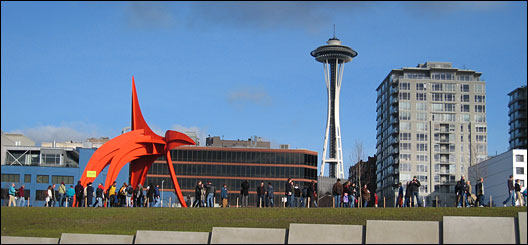
From various angles, you can see cars whizzing by, an Amtrak train chugging its way to the port, a ferry heading off to Bainbridge Island, or a seaplane gliding overhead. On a clear day — if you can find one — you can see the Space Needle, the Olympic Mountains, and Mount Rainier. “It’s one of few spots downtown where you can look back at the city and really see it,” Wyckoff says.
To realize that just 10 years ago this patch of land was part of a contaminated dump site is to feel hope that environmental work can make a real difference. To sit and watch runners, rollerbladers, and families with strollers fill the space is to know that it can.
Back to the Future
While seamlessly connecting green space to the urban setting, the park is also rich with the region’s cultural history. Like the art installations, all of the “living” exhibits are marked with informative plaques — from the tallest aspen down to the tiniest bit of groundcover. And each is labeled first in Lushootseed, the native language of the local Salish tribes, then with the Latin genus/species and English common names. Indigenous plants of medicinal value are marked by inscriptions detailing their traditional uses.
In the Neukom Vivarium greenhouse, I came upon quite a different set of inscriptions — the names of Pacific Northwest naturalists adorning the stone wall opposite the “living log.” Standing in that space, breathing in the overpowering smell of wet earth as my eyes strained to adjust to the dim, grayish-green light filtering through the shaded windows, I felt an extra weight in the air, as if Carson, Muir, and Ehrlich were all there with me.
Though the park pays homage to the past, there’s no doubt that it’s a product of its modern times. The light-filled glass-and-steel PACCAR Pavilion at the top of the hill features a series of cantilevered roofs and stepped terraces that mirror the park’s overall Z-shaped path. And at the lowest point of the property — below sea level, actually — another innovative design: revitalization of the seawall habitat to provide nursery grounds for spawning salmon. The $5.7 million project involved lowering some 50,000 tons of rock into the water to create a habitat “bench” — a 10- to 15-foot-wide shallow area for juvenile chinook and their favorite munchies.
Whose Art Is Heaven
When the park opened in January, tens of thousands of people flocked to it the first weekend. Aside from criticism about the lack of Native American art (a representation the Seattle Art Museum promised but has yet to fulfill) and a hands-off policy that comes across as confusing in such an open-to-the-public space, the response to the park has been largely positive. City planners in New York and Paris have taken notice of the way the park unites the city and shore, and art critics have praised the careful siting of the works.
While we were on our tour, Project Manager Chris Rogers got a call letting him know that the OSP had been nominated for a prestigious international award. The pride in Rogers’ voice was evident as he explained that the Veronica Rudge Green Prize in Urban Design recognizes large-scale works that make a substantial contribution to a city’s urban environment. In mid-March, the Harvard University Graduate School of Design announced that OSP design firm Weiss/Manfredi had won the award, the first time a U.S. project would receive the honor.
Rogers put it well when he said one purpose of the park is to explore “how we, through art, relate to nature.” And perhaps the most perfect embodiment of that sentiment was a scene that unfolded during one of my solitary returns: visitors wandering by the shore began creating sculptures of their own from driftwood and rounded pebbles. As I watched, it made me truly appreciate all the thought that had gone into creating this urban green space, into making it accessible and relevant to the local community.
“All of it is in hopes that it connects us to our environment,” Wyckoff says. “That we pause for a moment and reflect on our place in the Northwest at the water’s edge.”
